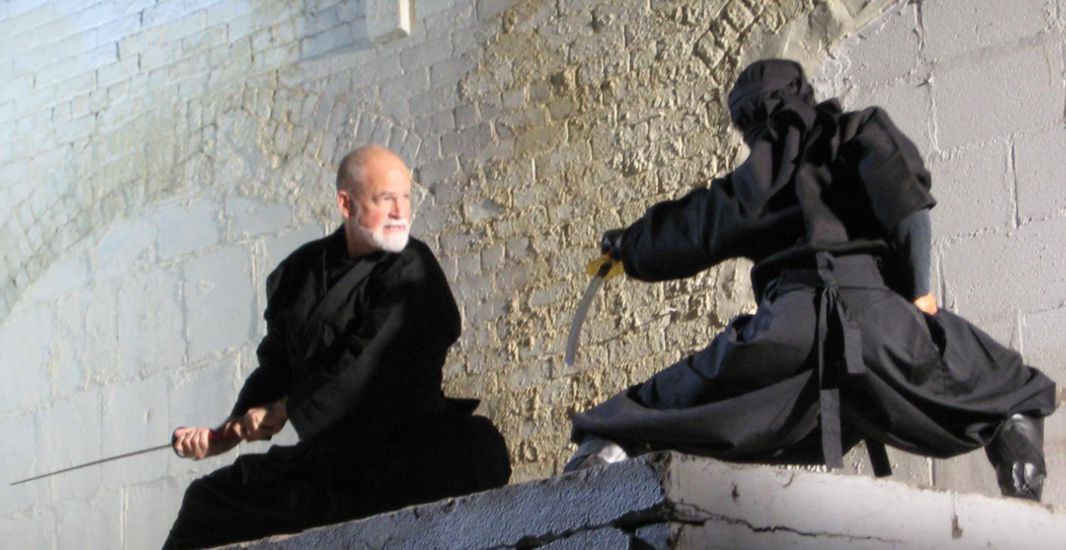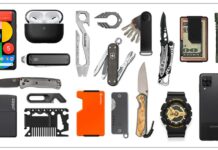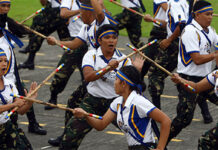As a student of the ninja personal protection martial art, based on fighting principles developed for intelligence gatherers in Japan centuries ago, you are training to promote more security in the world. With the goal of more safety on the streets, in the schools, and at the workplace, it is helpful to explore and understand a rational hierarchy of progressing phases of escalating demand for defensive techniques.
The ninja knew that the best way to defeat predators was to be invisible in their eyes. If they do not know you exist, they cannot gain access to you. Next best is to convince the predator not to choose you as a victim.
If you look well prepared, you look difficult to victimize.
If you look well prepared, you look difficult to victimize.Further down on the list of responses is to fight back way more effectively than a predator would have imagined you could. Actually, fighting is not the best or most preferred way to maintain security, but nonetheless, a possible requirement to be sure the good person goes home happy and healthy.
In a martial art dedicated to shielding good people from the insanity and horror of predatory violent aggression, there are several possibilities for handling hostile encounters without having to resort to physically engaging another person in a fight.
Bear in mind, the objective is to stay as safe and happy as possible throughout your day, not to go hunting for all the rats and rascals in your community so you can “give them a good lesson.” We are committed to creating and sustaining honest peace in the world. We are not seeking out and relishing opportunities to stir up more violence.
In a fighting contest, you know the intention of the person across from you. Out in the world, it may be more difficult to know what is ahead. An aggressor stepping in front of you may very well be a dangerous predator, experienced and practiced in the ways of shattering bright lives as a brawler, robber, rapist, or killer. Or those giving you a hard time may just be rough people who feel your presence in their space, or on their turf, is some kind of challenge.
It is also just as possible that the person raging at you is a normally harmless citizen, now temporarily confused and out of control over some unexpected frustration. What is your best defense? A kind word, a firm warning, a kick to the stomach, a gun barrel under the jaw? How will you know the best thing to do?
The following description of phases of progression in the need for defense may inspire you to train for as many protection options as possible. At the top of the list is simply not being where hostility roams.
Fighting other people is way down on the list of best solutions to conflict or confrontation. By no means is an angry fistfight your top choice in every rude encounter. Your ideal is to bring about peace. Your hope is to do that before things degenerate to a brutal scuffle against a person who feels he has nothing to lose. There are several ways to accomplish this.
1. Plan Ahead for Safety
Make it hard for danger to pin you down. Start with developing the habit of proactively planning to avoid conditions that could lead to the need for self-defense. Disappear from danger. Structure your life so that no one thinks of making you his target. You will need a set of plans to:
- Protect your home – When you and loved ones are there, and when nobody is there
- Protect you and your loved ones while away from home – at school, at work, while traveling, etc.
- Protect your assets not kept at home or in your pocket – things vulnerable to fraud and theft
Be proactive. Make a commitment to living a fulfilling life as free as possible from stress-induced dangers. Set your life up to encourage pleasant days. As much as you can, surround yourself with happy, healthy, positive, and productive people.
Pick a place to live where you are least likely to run into violence. Choose a job where confrontation potential suits your temperament comfortably. Reject the powerlessness of thinking you have no choice when it comes to the people and places your life brings you.
Once you have positioned yourself to be as free as possible from potential violence and hostility, set up passive measures of protection. Create external safety structures and procedures for your home and workplace. Effective lighting, sturdy locks, clear lines of vision, secure parking, a reduced profile not flaunting wealth or privilege, and discrete name usage in public listings, all help make it difficult for violence to find you and gain access to you.
Next, set things up to be ready for an emergency escape, so you can disappear from danger if need be. Plan evacuation routes, concealment spots, and caches of defense tools like flashlight, whistle, and appropriate weapons at home and work.
Keep your car ready for possible emergencies, tuned up and gassed up and equipped with route finders, and basic medical and survival protection kits.
Ever-changing social and cultural realities require heightened alertness and tactical adaptability to counter sophisticated subtle threats. Some of the most damaging attacks you could face could be carried out remotely.
How do we, as martial arts students, train to defend against cybercrime like identity theft? How do we defeat cyber bullying where lives are shattered by cruel personal attacks and slanders? Are protective measures against attacks that are not direct physical attacks valid subjects for self-defense study?
Beyond skillful passive preparation, practice scanning for the possibility of danger. Pay attention when you are out and about, away from areas where you normally control with confidence, your degree of safety and security.
Keep your senses open for hints of trouble. Be on the lookout for suspicious behavior or conversations. Tune into the energy of your surroundings. Be ready to go someplace better for you, if you sense something is wrong. Certainly enjoy a cheerful attitude towards life, relish your daily opportunities for new adventures, but do not become fooled into disregarding the potential for bumping into harm.
Stay alert. Notice the numbers, positions and the look of people around you in public places. Consciously assess any threatening individuals. Note their size and strength, their demeanor, apparent emotional state, and position in relation to you.
What are the messages behind their movements, dress, and deportment? Look for possible escape routes if things should go bad. Identify things that could serve as barriers and shields against attack. Scan for possible objects you could pick up and use as defensive weapons if needed.
Stay conscious of your own state from moment to moment. What are your strengths? What are your weaknesses or limitations? What is your level of proficiency with self-defense skills? How do your feelings and mood, in the moment, impact what you are experiencing and seeing? Do any possible legal or social considerations influence your choices of action? What is the smartest move if danger comes near to you?
3. Evacuate to Safety
When you feel endangered, just leave. Get out of there. When things turn suspicious, creepy, or threatening, disappear. Go someplace else where danger is less likely to reach you.
Leaving for a safer spot will give you the best possibility for avoiding physical and emotional wear and tear, and injury, not to mention, avoiding follow-up legal and courtroom repercussions that could interrupt your life as a result of a fight.
Even winning a fight can have its costs. You might pay a price for coming out on top. The loser could get in a good shot before going down, or you could damage your hand knocking him out. Your life could be disrupted and your time wasted. Police will need to get involved.
Legal charges could be pressed against you. Follow-up difficulties could show up after you thought the fight was over. The defeated troublemaker could win a judgement against you, or commit to a vendetta of revenge against you.
When someone tries to initiate an inappropriate conversation or spark a conflict, you can just walk away without a word or a glance. Just leave.
If you need to break an uncomfortable connection with someone you do not want to deal with, you can create a ruse to make it look like you did not notice the threatened aggression.
Act like you just remembered something and turn abruptly and walk away. Pat a pocket or two like you are missing something and walk back to the safe place you came from. Reach in your pocket and pull out a phone as though you got an important call and walk off looking for a quieter space.
Just leave. Do not get pulled into further conversation. Do not reply to an aggressor’s accusations. Do not argue. Do not apologize or explain what you are doing. Do not dignify them by justifying yourself.
Keeping the aggressor in your attention so you cannot be hit or grabbed from behind, walk away. Go where it is safe and sane and you are welcomed and appreciated.
4. Defuse the Tenseness
Take charge of the confrontation and defuse the tenseness if there is still time or space to interact effectively. Perhaps you can use words and physical cues to change the tone of the moment and convince an agitated or belligerent person that rationality is a better route to resolution.
Remember to maintain a higher level of awareness than the other person. You will need a more secure sense of centeredness and broader vision than the person opposing you. Stay elevated. Be mindful to avoid being pulled down to a lower level by anger and loss of emotional control.
Project a calm presence by breathing deeply and regularly. Hold a confident and alert facial expression and body posture. Maintain eye contact with the person. Move with calming ease and avoid sudden or jerky actions that could surprise the agitated or dangerous person and spark their attack.
Carefully position yourself where you can defend yourself, if you cannot calm the aggressor and things blow up. Stay out of reach. Put a barrier between yourself and the antagonist if you can. Stand off-center and angle yourself so you can pull back from a sudden strike or grab. Keep your hands free, unencumbered or empty if possible. Be ready for action.
Speak slowly and evenly. Keep your voice calm and low. Avoid threats, insults, demands, condescending statements, or any words that would give the other person further cause for blowing out of control. Acknowledge the agitated person’s feelings, if it might bring the situation to a calmer level, “I can see how you would feel angry.”
If necessary, you can say something to excuse yourself without opening up further challenge. “Hey, I’m just looking for someplace to get a beer and watch the ball game. I don’t need to fight. I’m leaving.” You can use gracious, but nonetheless, firm language. “I appreciate the invitation, but I have friends I promised to visit. Thanks. I’m off.”
With extreme care, you might use confident, light humor to make yourself the butt of the joke. Being careful not to appear weak. Show the other person you have no need to fight and defeat them. Say with a wry smile, “You’re the third person today who wants to kick my tail. Man, I’m aggravating everybody today. Let me just get out of here and quit bothering you.”
5. Confront and Dissuade
Interrupt the aggressor’s momentum towards violence and command him to leave you alone. Actively and directly resist the aggressor’s demands and demonstrate your unwillingness to submit in the way such a person expects from a victim.
Some people will not allow you to de-escalate the violent build-up because they actually like confronting others and making them uncomfortable. Such aggressors enjoy intimidating and exerting power over others. They are driven by a need to control, dominate, and humiliate. Showdowns are their stock in trade.
An attack could begin with the aggressor testing you out. He may try a few words or actions to see whether you resist or submit.
In effect, he is interviewing you for the role of victim. Your confident assertive refusal to go along with such offense, in the early stages of testing, may give him cause to move on in search of a more submissive target.
Firmly stand your ground in a confident and watchful manner. Maintain eye contact. Avoid movements that could hint at timidity or lack of resolve. Breathe deeply and regularly and state in your deepest voice that you will not be controlled or intimidated. “Stop it now. Back away from me.”
State in direct language that you know what they are doing. “I don’t like the threatening tone of your voice. Do not speak to me like that.” Make reasonable firm commands for what you want done. “We have nothing to discuss. You get in your car and I’ll get in my car and we’ll both get on with our lives.” Communicate your expectations clearly. “This conversation is over. I want you to move away from me right now.”
Call attention to yourself with your voice and actions. Make it clear to all who might move to aid you that you are resisting offensive behavior. Let everyone know you will not tolerate abuse, you are not fooled by what is going on, you do not want any connection with the aggressor, and you will not be a passive victim.
6. Physically Stop the Attacker
Sometimes your only route to safety is to intervene physically to stop another person from doing harm. Of course the safest method in the long run is to avoid or prevent physical aggression, but that is not always possible. Perhaps you cannot retreat fast enough or your attempts to diffuse or dissuade an aggressor do not work.
At such times, you will have to rely on your self-defense skills to stop an attack. You will want to be a far more effective and efficient fighter than the predator ever imagined you to be. You will have to call up your trained physical capabilities, your knowledge of technique and strategy, and fiercely determined fighting spirit.
In a physical assault, your objective is to end the fight as quickly as possible and get yourself and others away from further danger. Ideally, you want fighting skills with techniques that are efficient, produce immediate results, render the attacker unable to continue the assault, and cut to the shortest time possible, your need to be in contact with your assailant. You want to neutralize the assault quickly and decisively and get away to safety.
A self-defense situation is a far cry from a sports fighting match. A brutal, violent, physical battle for life, between human beings, is not at all a thing of entertainment, sportsmanship, or proving one’s toughness.
The knowledge and skills needed for safety on the streets, or to win a street fight, are very different from those needed to defeat a fellow athlete in a contest. Unseen knives are pulled from boot tops. Buddies or fellow gang members jump on a defender, who thought he was fighting one single attacker. Gunfire blazes in what was thought to be a hand-to-hand, shove-around, hassle fight.
Safety on the Streets requires that you train honestly to be as prepared as possible. To develop reliable self-protection skills, you must study under the guidance of mentors who understand the realities that make up the world of depraved humans who relish violence. A good teacher, and an honest program, will help keep your expectations and training exercises on target and authentic.






